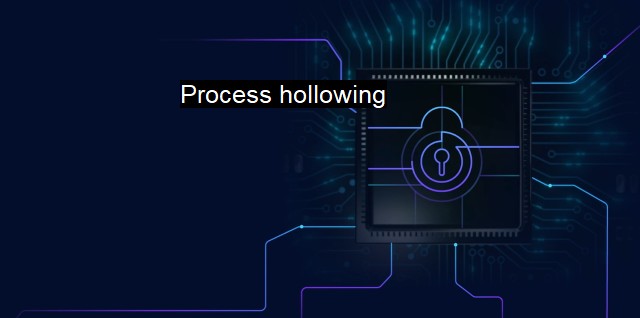What is Process hollowing?
The Gravest Threat: Unpacking Process Hollowing as an Highly Effective Malware Delivery Technique
Process Hollowing is an advanced cyberattack technique linked with malware attacks. It involves the intrusion of a specific process by a determined cybercriminal, crept into a system to take command of one or many targeted processes, damage vital data, interfere with the process activities, or even stop the process tasks enabling it to pave the way for more serious crimes. Often referred to as "ghostwriting," this technique seeks to infiltrate, hide and operate stealthily, thus making it more challenging for cybersecurity solutions and antivirus shields.Malware authors frequently use this method as a camouflage strategy to bypass antivirus detection and commit various cyber-felonies through hiding suspicious activities within a legitimate process scope. For instance, an attacker may utilize process hollowing on frequently used processes, such as web browsers, email, word processors, or operating systems apps to illicitly perform a malicious act while staying under the radar.
The concept of Process Hollowing revolves around an attacker creating a new instance of a legitimate process, then pushing their unscrupulous code into the newly duplicated process. Once the target process has been chosen, a new process is launched in a suspended state. This state witnesses no activity other than to house the suspicious elements introduced by the attacker. At this point, the attacker can replace the process memory with their malicious code. After achieving this, the cyber criminal eventually resumes the hollowed process and lets it run malicious codes under the garb of a legitimate operation. Naturally, such a deceiving manipulation earns its low-profile nature, being unsuspected by most systems and antivirus software.
This kind of attack can often be invisible to regular protection environments, as the malware hides in the shell of a trusted process. This usurped process presents the threat as being genuine, leading many security systems to ignore such a risk. Process hollowing drastically reduces the attacker's visibility on running processes lists and security audits, flourishing the crime with ease.
Any meaningful prevention and resolution of such nefarious events necessitate a sophisticated and regularly updated defensive strategy that proactively identifies signs of intrusion before severe impacts happen. An effective protective solution needs to observe and monitor the behavior and state of each task done in the system. If any process acts suspiciously or deviates from established baseline behavior, then immediate action should be taken to block it and find out the root cause.
There are numerous ways to detect process hollowing attacks, some of which include unusual process behavior analysis, spotting significant changes in process memory, or examining real-time data for any irregularities. Detailed code analysis and debugging of suspicious processes can often reveal process hollowing attempts concealed from regular antivirus algorithms.
One key solution to mitigate the risk is to have comprehensive and effective cybersecurity management. For instance, Behavior-based detection engines will examine abnormal routines and movements in a process. Antivirus software offering run-time protection can prevent unwanted alterations to the systems processes. Patching and updated intrusion detection and prevention systems also help identify and manage any malicious activities in real-time.
To sum up, process hollowing is a crafting trick rendered by cyber attackers to take advantage of outdated or vulnerable security systems. with a robust proactive cybersecurity strategy, modern mechanisms can recognize and stop such attacks before they lead to grave damage. Equipping systems with sophisticated antivirus and being mindful of system process behaviors must be a routine practice to ensure the integrity, security, and efficient operation of an entity's information and systems. Security in the digital age is the basic requirement nowadays, and given the complexity of threats, individuals and organizations need awareness about tools and threats, enabling them to face cyber challenges more confidently.

Process hollowing FAQs
What is process hollowing?
Process hollowing is a technique used by malware to hide its malicious behavior from antivirus software. It involves creating a legitimate process, then replacing its code with the code of the malware. The process then behaves normally to avoid detection while carrying out the malware's commands.How does process hollowing bypass antivirus?
Process hollowing works by manipulating legitimate processes and replacing their code with malicious code. Since the processes are legitimate, they are not detected as malicious by antivirus software, allowing the malware to execute undetected.What are some signs of process hollowing?
Some signs of process hollowing may include unusual process behavior such as high CPU or memory usage, processes running from unusual locations, or processes running with suspicious names. However, these signs alone may not be enough to detect process hollowing, and additional investigation may be necessary.How can I protect against process hollowing?
To protect against process hollowing, it is important to keep antivirus software up to date and use additional security measures such as endpoint security solutions. Additionally, users should exercise caution when downloading and opening files from unknown sources, and be alert for any suspicious activity on their system.| | A | | | B | | | C | | | D | | | E | | | F | | | G | | | H | | | I | | | J | | | K | | | L | | | M | |
| | N | | | O | | | P | | | Q | | | R | | | S | | | T | | | U | | | V | | | W | | | X | | | Y | | | Z | |
| | 1 | | | 2 | | | 3 | | | 4 | | | 7 | | | 8 | | |||||||